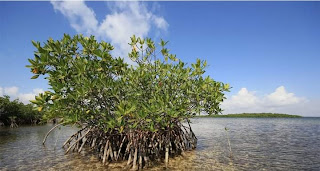In fact, any carbon trapped in the ocean is called blue carbon. Blue carbon is stored in coastal and marine environments. This carbon is stored in living organisms such as algae, mangroves, sea grasses and any marine plants, as well as dead organic matter such as dead trees and sediments.
Why Blue Carbon?
Governments of various countries around the world have set a target of ‘net zero emissions’ or ‘net zero emissions’ to reduce the impact of climate change. This means that as much greenhouse gas is released into the air, the same amount of gas is naturally removed from the air. This will be done through forest conservation or artificial means like carbon capture technology.
The US administration is investing in a promising area, called Blue Carbon, with the goal of net zero carbon emissions by 2050. The Ocean Climate Action Plan or Ocean Climate Action Plan announced in March 2023 gives special emphasis to this issue.
This matter is much like a carbon sink. A carbon sink is a natural or artificial reservoir that absorbs and stores carbon dioxide.
The main gas responsible for global warming is carbon dioxide or CO2. Scientists are now researching how blue carbon can be used to combat the carbon-dioxide problem. They warned, the blue carbon approach cannot yet be called the main solution to solving the climate crisis. However, marine ecosystems can store more carbon than forests in some cases.
What Is Blue Carbon?
First of all it is good to know that blue carbon is actually not blue. Blue is named to reflect its association with the sea.
As we know, carbon dioxide is like food for plants. Plants take these nutrients from the atmosphere and convert them into different parts of the plant body through photosynthesis. Sea and coastal plants also take in carbon dioxide for the same reason.
Carbon-storing plant parts are buried under sediments on the ocean floor for various reasons. There they accumulate for hundreds or even thousands of years. This process creates a sink or reservoir of carbon.
These ecosystems created by nature benefit humans. There are other examples of ecosystems such as forests, which purify the air. Or wetland plants, which help reduce storm surges. Besides, plants have a role as our food.
We consider blue carbon as a service in economic terms. We get these services from coastal ecosystems, but we don’t have to pay for them.
When researchers talk about blue carbon in the United States, they are referring to ecosystems of salt marshes, mangrove forests, seagrass meadows, and kelp (a type of aquatic plant).
Mangrove forests occur south of Florida, in parts of Texas and Louisiana. And most algae gardens are found on the West Coast. Salt marshes are usually found along the seashore. And where there is sea water, sea grass is found.
A study published in 2020 in the journal Frontiers in Marine Science shows that the top one meter of open ocean floor sediments can store twice as much carbon as soil. Plants and animals that store carbon sink after they die and the soil is buried under the ocean floor. A single-celled organism called phytoplankton has a huge role behind this whole phenomenon. Phytoplankton is spread throughout the ocean.
But the oceans are so vast that it is difficult to calculate how much carbon is being stored in them. More importantly, measures to increase carbon storage in the open ocean (such as increasing phytoplankton) are not yet recognized as coastal ecosystem management and are not recognized as viable strategies.
But Why Is Blue Carbon Important?
Many researchers, however, insist that blue carbon will not solve the climate crisis. But it is among the many steps states can take to achieve the goal of zero emissions.
Coastal ecosystems in the world cover only a few hundred thousand square kilometers. Although small in volume, they are quite effective for carbon absorption. Mangrove forests, salt marshes and seagrasses can store carbon 10 times faster than soil ecosystems. Carbon storage in these environments is 4 times higher than terrestrial forests.
Coastal ecosystems are more efficient than forests in carbon storage for two reasons. The first reason is that carbon not only resides in plants, it also gets absorbed into sediments. Second, coastal ecosystems also bring in carbon from other environments. As tides wash over coastal forests, many organic materials containing carbon are carried with them. These materials also become trapped in sediments and store carbon.
When a giant tree falls in a forest, it stays in the forest for years. Then fungi, insects and microorganisms quickly break down the tree’s wood and roots. Finally, the carbon in the plants is released back into the air as carbon dioxide.
Just as we eat food and release carbon-dioxide, these microorganisms eat plant parts and release carbon-dioxide. Thus carbon cannot be stored for very long. So we can say that carbon cannot be locked up for long in this ecosystem.
But once carbon is sequestered in coastal sediments, it stays there. Unless humans disrupt this system for some reason. When bulldozing or dredging salt marshes or mangroves, large amounts of carbon are released into the air.
How Much Blue Carbon Can Be Used?
Regenerating a forest and restoring a blue carbon ecosystem are different things. Care must be taken here, so as not to expect too much from blue carbon.
These ecosystems live in places that are difficult to reach. As sea grass is submerged in water, you won’t see much of it.
As a result, such aquatic forests become difficult to maintain. We now need a better way to sustain this restoration and conservation work.
If these coastal ecosystems can be restored, it will do much more than just carbon storage. These natural areas can protect coastal communities from storm damage, provide safe harbors for commercial fisheries, and even create tourism opportunities.
In fact, blue carbon can be one of many steps in mitigating climate change. It is not a Brahmastra that will solve the problem. But if we can’t protect ecosystems and reduce carbon emissions, we’re going in the wrong direction.


